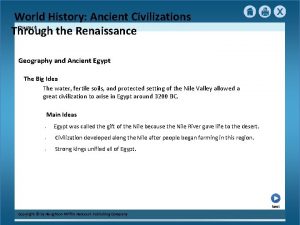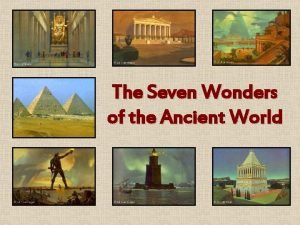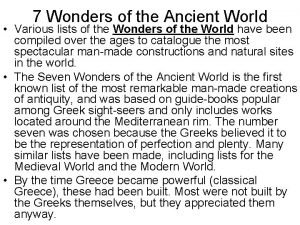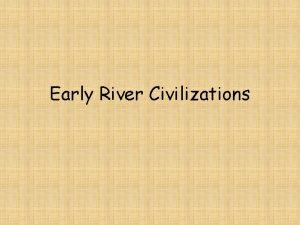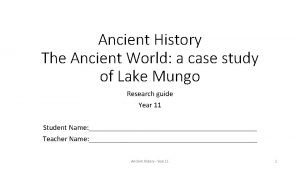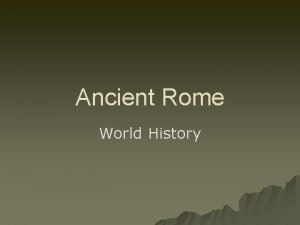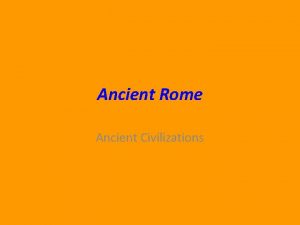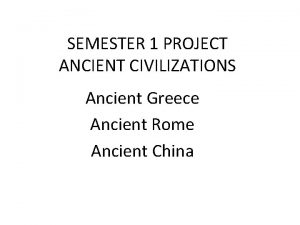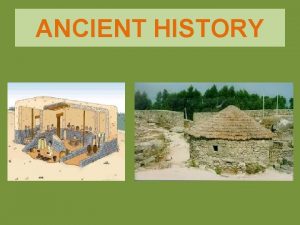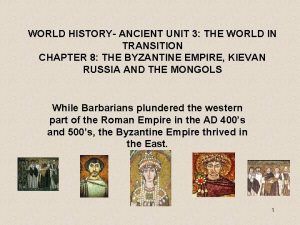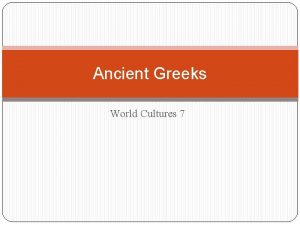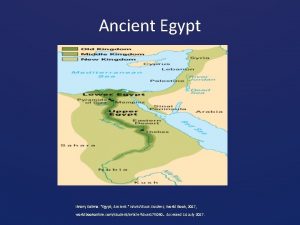Guide to the Ancient World History I History


















































- Slides: 50

Guide to the Ancient World History

I. History and Historiography 1. Introduction l History l l l Historiography: The written record of l l l Broadest Sense: is the totality of all past events; limited Sense: is the known past. What is known of human lives and societies in the past; How historians have attempted to understand them. Historian: l l To collect and record facts about the human past; To discover new facts.

I. History and Historiography 2. Sources and Facts l Sources l Testimony from living witnesses; l l l Narrative records Previous histories Memoirs Letters Imaginative literature;

I. History and Historiography 2. Sources and Facts l Sources l l l Testimony from living witnesses; The legal and financial records of courts, legislatures, religious institutions, or businesses; The unwritten information derived from the physical remains of past civilizations l l l Architecture Arts Crafts Burial Grounds Cultivated Land.

I. History and Historiography 2. Sources and Facts l l Sources Evidence & Facts l l Sources provide the evidence To decipher facts from the evidence

I. History and Historiography 3. Interpretation and Form l Interpretation l l l Selection, arrangement, and explanation of historical facts Selection of a subject Historiography and Literary Art

II. Civilizations 1. Definition: a developed or advanced state of human society 2. Description l l People live in urban centers People have productive survival, such as agriculture and smelting metals People have live in the complex political, economic and social structure, under religious and law abiding People have developed a method of writing in all meanings of the word

III. Why Study Ancient World Cultures? 1. A part of a tradition of intellectual development 2. To Open Our Mind l l We must always guard against the assumption that other people think as we do -- or that they should. Reading about ancient cultures is thus reading about other people whose lives were surely different from our own. These differences may help us better to see -- and know -- the limits of our culture and the limits of our language and experience. A culture includes both the dominant tradition and its transgression

IV. Prehistory 1. Time before written records appeared 2. The Stone Age, the Bronze Age, and the Iron Age 3. The nature and events of prehistory can be reconstructed through archaeology

V. Stone Age 1. Introduction l l Definition: Stone as the principal raw material for tools 2 500 000 million - 5 000 years ago Distinguish between human and other animals: stone toolmaking and tool-using Beginning of the Stone Age

V. Stone Age 2. Study of the Stone Age l The Origin of the Term "Stone Age"

V. Stone Age 2. Study of the Stone Age l l The Origin of the Term "Stone Age" General Concepts l l Anthropology and Archaelolgy Stone Artifact l l l Artifact: Objects that have been modified by human action, either intentionally or unintentionally. Tool: Something that has been used by a human for some purpose. Human Evolution l l Genus Homo and Genus Australopithecus Homo habilis, Homo rudolfensis, Homo erectus, Homo Neandertals, Homo sapiens

V. Stone Age 2. Study of the Stone Age l l l The Origin of the Term "Stone Age" General Concepts Stone Age Tool-making Technology l l Techniques Core, Flakes, Retouched Piece, Hammer-stone


V. Stone Age 2. Study of the Stone Age l l l The Origin of the Term "Stone Age" General Concepts Stone Age Tool-making Technology l l l Techniques Core, Flakes, Retouched Piece, Hammer-stone Industry

V. Stone Age 3. Divisions of the Stone Age l l l Paleolithic: Old Stone Age, the stage in which stone tools were flaked. Mesolithic: Middle Stone Age, the period is characterized by the creation of implements. Neolithic: New Stone Age, the stage in which ground and polished stone tools became prevalent.

V. Stone Age 4. Lower Paleolithic l l Date: 2 500 000 - 200 000 year ago Oldowan Industry l Stone Artifacts

Oldowan Tools

Oldowan Toolmaking

V. Stone Age 4. Lower Paleolithic l l Date: 2 500 000 - 200 000 year ago Oldowan Industry l l l Stone Artifacts Other Tools Sites Hominids: Homo erectus Daily Life l l l To live near water sources To transport stone several kilometers to other sites To Process Animals Carcass

V. Stone Age 4. Lower Paleolithic l l Date: 2 500 000 - 200 000 year ago Oldowan Industry l l l Stone Artifacts Other Tools Sites Hominids: Homo erectus Daily Life Food l l l Meat from animal carcasses Hunting smaller animals Plant foods

V. Stone Age 4. Lower Paleolithic l l l Date: 2 500 000 - 200 000 year ago Oldowan Industry Acheulean Industry l Acheulean hand axe

Early Acheulean Handaxe

Late Acheulean Handaxe

V. Stone Age 4. Lower Paleolithic l l l Date: 2 500 000 - 200 000 year ago Oldowan Industry Acheulean Industry l Acheulean hand axe l l l Oval-shaped form, Bifacial Flaking, Soft-hammer Technique Not to replace Oldowan tools entirely Most of sites in Africa, Europe and western Asia, few in East Asia Sites Hunting Fire

V. Stone Age 5. Middle Paleolithic (ca. 200, 000 -30, 000 years ago) l l Levallois Produced Tools Neandertals

Neandertal Bones

Neandertal and Modern Human Skulls


V. Stone Age 5. Middle Paleolithic (ca. 200, 000 -30, 000 years ago) l l l Levallois Produced Tools Neandertals Sites l l l Germany: Neander Valley Iraq: Shānidār Israel: Tabun, Amud China: Dali, Maba South Africa: Florisbad

V. Stone Age 5. Middle Paleolithic (ca. 200, 000 -30, 000 years ago) l l l Levallois Produced Tools Neandertals Sites Hunting Dailylife l l Fire use and Fire-making Evidence of housing Hominids’ Spread: Australia, by 40, 000 years ago Culture: burials, ornaments

V. Stone Age 6. Upper Paleolithic (c. a. 40, 000 – 10, 000 years ago) l Characteristics of Upper Paleolithic l l l Stone Artifacts Human’s Spread: American Continents (12, 000 -10, 000 years ago) Cro-Magnon Man

V. Stone Age 6. Upper Paleolithic (c. a. 40, 000 – 10, 000 years ago, Paleo. Indian Period, Later Stone Age) l l Characteristics of Upper Paleolithic Innovations of the Upper Paleolithic l Tools l l l Tools of bone, antler and ivory Lamps Bow and arrow Composite technology Hunting and gathering

Mammoth Hunt

V. Stone Age 6. Upper Paleolithic (c. a. 40, 000 – 10, 000 years ago, Paleo. Indian Period, Later Stone Age) l l l Characteristics of Upper Paleolithic Innovations of the Upper Paleolithic Culture l l Housing: hut or tent Trade and transport Burial Upper Paleolithic Art

Cave Painting

Cave Artin southeastern France

V. Stone Age 7. Mesolithic (ca 10, 000 – 7, 000 years ago) l l Foodstuffs Technological Innovations

Stone Point for Making Spears

Jōmon Pottery

V. Stone Age 8. Neolithic (ca 9, 000 – 5, 000 years ago) l Revolution in the history of human l l l More permanent settlements Much Larger Populations Accumulation of surpluses and wealth Development of more profound status and rank differences within populations Rise of specialized crafts

V. Stone Age 8. Neolithic (ca 9, 000 – 5, 000 years ago) l l Revolution in the history of human Tool-making l l l l Blade and bladelet technologies Ground and polished axes Grinding Stones for the Processing of Cereal Foods Use of Pottery for Surplus Food Storage and Cooking Construction of Granaries for Storage of Grains Use of Plant for Textile Weaving Technology

V. Stone Age 8. Neolithic (ca 9, 000 – 5, 000 years ago) l l l Revolution in the history of human Tool-making The Rise of Farming l The reasons of farming l l l Population pressure or changes in environment Region where it was relatively easy to domesticate wild plants and animals Function of social change

V. Stone Age 8. Neolithic (ca 9, 000 – 5, 000 years ago) l l l Revolution in the history of human Tool-making The Rise of Farming l l The reasons of farming Crops l l l Near East: wheat, barley, legumes, grapes, and olives China: millet and rice Africa: millet, African rice, and yams Southeast Asia: Rice, bananas, coconuts, and yams Americas: corn, squash, beans, potatoes, peppers, sunflowers

V. Stone Age 8. Neolithic (ca 9, 000 – 5, 000 years ago) l l l Revolution in the history of human Tool-making The Rise of Farming l l l The reasons of farming Crops Domesticated animals l l Eurasia: dogs, sheep, goats, cattle, pigs, chickens, ducks, and water buffalo Americas: dogs, turkeys, llamas, alpacas Africa: cattle, sheep, and goats Architectural developments

V. Stone Age 8. Neolithic (ca 9, 000 – 5, 000 years ago) l l Revolution in the history of human Tool-making The Rise of Farming Neolithic Social Change l l Wealth for some individuals Social differentiation Trade between different areas More complex social organization

V. Stone Age 9. The End of the Stone Age l l Metal tools: copper, Bronze The rise of the earliest state societies and civilizations

VI. Bronze Age 1. Bronze Age, the time in the development of any human culture, when most tools and weapons were made of bronze. 2. Bronze came into use, and was again replaced by iron, at different times in different parts of the world. l l l Middle East: 4500 BC Asia Minor: 3000 BC Greece: 3000 BC China: 1800 BC Americas: AD 1000

VII. Iron Age, period in the development of any culture, when iron was commonly used for making tools and weapons.

l What are the reasons for the late beginning of agriculture? l What forced the change to agriculture between 10, 000 and 2, 000 years ago?
 History alive chapter 8
History alive chapter 8 History alive the ancient world chapter 14
History alive the ancient world chapter 14 Chapter 3 from hunters and gatherers to farmers
Chapter 3 from hunters and gatherers to farmers Ancient civilizations through the renaissance
Ancient civilizations through the renaissance World history and geography final exam study guide
World history and geography final exam study guide World history final exam review
World history final exam review How useful is this source
How useful is this source World history 1st semester final review answers
World history 1st semester final review answers Chemistry fall semester exam review answers
Chemistry fall semester exam review answers Pictures of ancient and modern means of communication
Pictures of ancient and modern means of communication Ancient india vs ancient china
Ancient india vs ancient china Ap world history chapter 25 africa and the atlantic world
Ap world history chapter 25 africa and the atlantic world Countries michael jackson visited
Countries michael jackson visited Seven wonders of the ancient world map
Seven wonders of the ancient world map 7 woders of the world
7 woders of the world Wonders of the ancient world map
Wonders of the ancient world map Clothing in the ancient world
Clothing in the ancient world 7 wonders of the ancient world names
7 wonders of the ancient world names 7 wonders of the ancient world map
7 wonders of the ancient world map River valley civilization
River valley civilization Hình ảnh bộ gõ cơ thể búng tay
Hình ảnh bộ gõ cơ thể búng tay Bổ thể
Bổ thể Tỉ lệ cơ thể trẻ em
Tỉ lệ cơ thể trẻ em Gấu đi như thế nào
Gấu đi như thế nào Glasgow thang điểm
Glasgow thang điểm Chúa sống lại
Chúa sống lại Các môn thể thao bắt đầu bằng tiếng nhảy
Các môn thể thao bắt đầu bằng tiếng nhảy Thế nào là hệ số cao nhất
Thế nào là hệ số cao nhất Các châu lục và đại dương trên thế giới
Các châu lục và đại dương trên thế giới Công của trọng lực
Công của trọng lực Trời xanh đây là của chúng ta thể thơ
Trời xanh đây là của chúng ta thể thơ Cách giải mật thư tọa độ
Cách giải mật thư tọa độ 101012 bằng
101012 bằng Phản ứng thế ankan
Phản ứng thế ankan Các châu lục và đại dương trên thế giới
Các châu lục và đại dương trên thế giới Thơ thất ngôn tứ tuyệt đường luật
Thơ thất ngôn tứ tuyệt đường luật Quá trình desamine hóa có thể tạo ra
Quá trình desamine hóa có thể tạo ra Một số thể thơ truyền thống
Một số thể thơ truyền thống Cái miệng xinh xinh thế chỉ nói điều hay thôi
Cái miệng xinh xinh thế chỉ nói điều hay thôi Vẽ hình chiếu vuông góc của vật thể sau
Vẽ hình chiếu vuông góc của vật thể sau Nguyên nhân của sự mỏi cơ sinh 8
Nguyên nhân của sự mỏi cơ sinh 8 đặc điểm cơ thể của người tối cổ
đặc điểm cơ thể của người tối cổ Giọng cùng tên là
Giọng cùng tên là Vẽ hình chiếu đứng bằng cạnh của vật thể
Vẽ hình chiếu đứng bằng cạnh của vật thể Phối cảnh
Phối cảnh Thẻ vin
Thẻ vin đại từ thay thế
đại từ thay thế điện thế nghỉ
điện thế nghỉ Tư thế ngồi viết
Tư thế ngồi viết Diễn thế sinh thái là
Diễn thế sinh thái là



